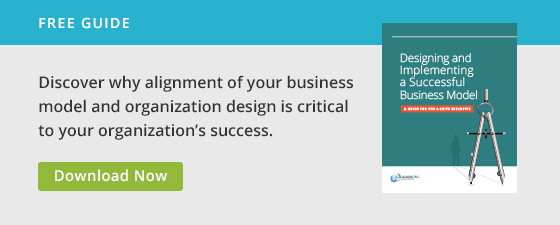In business model implementation, no real change can take place until and unless people begin to act or behave differently—and there is a big difference between thinking about this being done and actually having it happen. While this may seem obvious, disconnects between concept and action happen surprisingly often in organizations. Understanding how and why these disconnects occur can help leaders ensure full execution of their vision for the organization.
These disconnects between idea and action fall into two interconnected categories: disconnects of time and disconnects of understanding.
Understanding the Dynamics of Change
Because the work leaders do takes place at the speed of thought, it’s easy to forget that further actions are necessary to implement those ideas. Often, the first action that needs to be taken is to help people understand the vision.
People need to understand what the change is, why it is happening, how it is supposed to happen, and what their role is in making it happen. From an execution standpoint, it’s easy for leaders to communicate what they’re thinking and assume that saying it will immediately lead to understanding. This is not usually the case. People need to work with something before it becomes their own. They have to do the process, assimilate it, and see and experience how the new structure or process works. Developing understanding takes time.
Allowing Time for Understanding
Leaders often forget how long it took them to wrap their heads around a new reality. They may have spent two or three months in intense work sessions to architect where they want to take their organization. When they’re done, it makes perfect sense to them—so much sense that they often assume others can get it quickly. There is a tendency to rob people of the time it takes to acclimate to the new way of thinking.
If individuals need time to absorb a new idea, so do groups and organizations. Because leaders are on the leading edge of the organization, and are responsible for envisioning where to take it next, they have a tendency to want to jump forward and move on to the next thing more quickly than the organization can follow.
For instance, if a leader communicates a change in March it may take until October before that change is communicated to and assimilated by the hundreds or thousands of people in a large organization who will ultimately enact it. By then, leaders may have already moved on to the next thing. And so the organization experiences whiplash, where the top of the organization feels like the bottom is moving very slowly and the bottom feels like things are never stable. Leaders may express frustration that the organization is not nimble, or is not able to take real-time actions. Organization members on the other hand may be asking questions like, “can’t we just set a direction and stick with it?” Much of this dynamic has to do with the unavoidable time delay between the leadership team’s understanding and the rest of the organization’s capacity to understand and follow through with the change.
How Leaders Can Ensure Proper Business Model Implementation
It’s important for leaders to understand this time delay dynamic because unless the work itself changes, the overall performance of the organization will not change. We’d like to see leaders stay involved in implementation to the point where they ensure that people’s work is changing. Don’t confuse this with micromanagement – that’s certainly not what we’re after, but we do want to take a business model change to a place where performance is indeed changing.
One of our clients this past year had been struggling for about five years to change one of their corporate functions. When we got wind of it, we sat down with them and had them show us how they had been approaching it. As it turned out, they had a solid plan. There was no reason they shouldn’t have been making progress. What we soon discovered, however, was they had never really implemented anything. They talked about it, and everyone knew what was supposed to happen, but no one had actually taken substantial action. People were waiting for this or that to happen, or were waiting for confirmation and approval, or feeling stonewalled because they didn’t have the system to do this or that. When it came to the bottom line, nothing was changing.
To prevent this kind of inaction from taking hold, leaders need to stay close enough and involved enough to make sure change happens. A good place to start is by taking these three business model implementation measures:
- Allow people the time and support they need to fully understand and assimilate the change. Consider if your trainings, process design, and/or channels of communication are supportive of the change.
- Hold people accountable. In the above example, a big part of the problem was lack of accountability. People in theory knew what needed to do, but they didn’t do it. They should have been called out, or someone even fired for not doing what was expected. Holding people accountable is essential to making the changes actually happen.
- Track the movement of work. A good leader will make sure they have a good project manager to help make sure the changes happens. Too often, project managers just track the to-dos and the milestones without tracking the movement of work and people to the future state. Great project managers will get to the level of detail where they say, “the biggest reason we missed this deadline is we don’t have the people in place here to even start doing this.” When work needs to be moved somewhere else, it is very helpful to map where that work is going and who’s taking it on.
We have a tool for that, which we call the Work Transition Plan. It facilitates the movement of people from where they are today to where they need to be in the future. We sometimes refer to it as our baton pass tool, because transitioning work in this way is like a relay race where one runner has to hand the baton over to the next runner in the race.
Even if a leadership team does organization design the right way—they pull a team together and really work to architect and design how they want the business model to function in the future—all that work goes by the wayside if the organization is not set up for proper execution. By understanding how an organization responds to change and staying involved long enough to see that the work itself actually changes, leaders can ensure successful implementation of their strategic goals.






